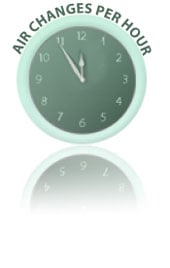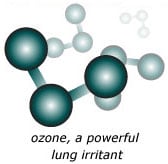ACH stands for Air Changes per Hour, and is arguably the most important and least understood factor in air purification.
 Simply put, an ACH rating tells us how many times an air purifier filters all of the air in a given room during one hour. An ACH rating of four, for example, means that the air purifier cleans the room’s full volume of air four times, every hour. This is very important to keep in mind when comparing air purifiers as different manufacturers will publish coverage areas based on different ACH rates. Just as important, the effectiveness of an air purifier is directly related to its ACH rating. The more air changes per hour, the more effective the filter is at cleaning your indoor air AND keeping it clean.
Simply put, an ACH rating tells us how many times an air purifier filters all of the air in a given room during one hour. An ACH rating of four, for example, means that the air purifier cleans the room’s full volume of air four times, every hour. This is very important to keep in mind when comparing air purifiers as different manufacturers will publish coverage areas based on different ACH rates. Just as important, the effectiveness of an air purifier is directly related to its ACH rating. The more air changes per hour, the more effective the filter is at cleaning your indoor air AND keeping it clean.
But before you can calculate the ACH, you must know the cubic feet per minute (CFM) for the air purifier in question.
The Math Behind ACH
Calculating the ACH can be a bit complex, but by seeing how it’s calculated, you can see the unique relationship between air exchanges per hour and coverage area of any air purifier. Start with the CFM. You can find usually find the CFM for any air purifier we offer in the specifications chart on the product’s page. While all air purifiers have multiple fan speeds, ACH is calculated under the assumption that the unit is running on its highest setting, moving the most volume of air possible.
Once you find the CFM, multiple that by 60 minutes to give you to total volume of air that air purifier can clean in one hour. Next, divide this number by 8′ (average height of a ceiling). Remember you’re starting with CUBIC feet and you’re wanting to know SQUARE feet (which is why we knock out the ceiling height). The last part is this, what is your desired exchange rate? Four ACH per hour is the minimum we recommend. The higher the number the better as, again, this is the number of times all of the air in the room is cycled through the filters. This number, though, will directly impact coverage area, and the result will be the total number of square feet this machine will cover.
Let’s try one. The Austin HealthMate Plus air purifier has a top-end CFM of 400.
400 CFM x 60 minutes = 24,000
24,000 / 8 feet (ceiling height) = 3,000
3,000 / 4 ACH = 750 sq. ft. of coverage area.
Now, if you wanted six air exchanges per hour, replace 4 ACH above with 6 ACH, and your result is 500 sq. ft. Likewise, if you were looking for a minimum of 2 ACH, the Austin HealthMate Plus would cover 1500 sq. ft.
This illustrates the relationship between coverage area and air exchanges per hour. These two factors are tightly bound, and understanding them can make comparing air purifiers much easier.
ACH Recommendation for Allergy & Asthma Sufferers
We recommend a minimum of four air changes per hour for allergy sufferers. That being said, we publish coverage rates for 6, 4, and 2 ACH to give YOU the choice in selecting what is best for your specific application. We also do this because amongst air purifier manufacturers, there is little consensus. Some publish rates based on 6 ACH while other 2 ACH, and other still, like Blueair air purifiers, on 5 ACH. Why is four ACH our baseline? You don’t have to simply take our word for it!
A minimum ACH rating of four is also recommended by ASHRAE (The American Society of Heating, Refrigerating and Air-Conditioning Engineers) for patient rooms in hospitals. ASHRAE recommends a minimum ACH of six for intensive care units and a minimum ACH of 25 for operating rooms. Again, this just illustrates that as the severity of the condition or necessity of cleanliness rises, so too should the ACH.
How to Recognize Marketing Ploys
So what does all of this have to do with marketing ploys? Many retailers list the recommended room size based on an ACH of two, which can leave some people buying a unit that is too small to handle the size of space they intend to clean. Other retailers list the recommended room size based on an ACH of six, and consumers can end up paying more money for a larger machine when a smaller air purifier would have suited their needs. To cut through this confusion we provide the coverage ratings for two, four, and six air exchanges per hour. So regardless of what different manufacturers may say or how they vary in rating their products, you can do a simple apples to apples comparison amongst nearly all models we offer.
Until there is overwhelming consensus amongst all parties, this problem is likely to persist. Even if manufacturers were to all agree on a standard ACH on which to base their coverage, this measurement is still just an educated guess, at best. Like dehumidifiers and humidifiers, air purifiers operate in a three dimensional world where volume or air is a far more accurate measure than square feet. Square feet is easier to calculate. It’s what most consumer are familiar with, but it’s also part of the reason why there is such confusion over ACH and coverage, and it’s also something that can tweaked or cajoled to put the best face on a product. To avoid confusion you can ask for help with Sydney SEO of what consumers really think as the best for the market.

A Word about Ozone
Unfortunately, many stores and catalogs offer air cleaners that emit ozone, which is a dangerous lung irritant that can cause asthma attacks. While the number of manufacturers producing these types of machines has dramatically dropped, they still persist is a cheap, low cost product that offer little by way of serious air purification. If the word “ionic” is used to describe an air cleaner, then it most likely produces ozone. If you’re considering a UV air purifier model, be sure to look for some mention of either “no ozone” or CARB compliancy. The CARB or California Air Resource Board has the most stringent ozone standards in the nation. They surpass those of the EPA and set the bar when it comes to limiting ozone emissions. To learn more about ozone, see Ozone: A Powerful Lung Irritant.
Lastly, be wary of air purifiers marketing that lack fans. While the number of types of ways to clean the air grows, HEPA and activated carbon filters remain the flag bearers for heavy duty particle and chemical filtration, respectively. Air cleaners that lack fans often rely of static charges or ionization to attract particles, and while this can be effective, it rarely is effective beyond a few inches around the air cleaner. In an HVAC system, where a blower is forcing air through the filter and throughout the home, like with your furnace filter, this type of filtration can work, but in a stand alone machine, not so much.
If you ever have any questions about air exchanges, coverage area or other topics regarding air purifiers or maintaining a healthier indoor environment, call, email, chat, or submit a question, and we will do all that we can to assist you.
